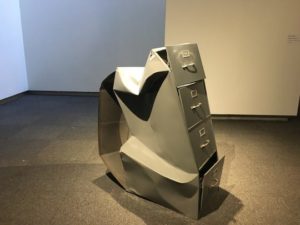EXTRASENSORY2: A Different Kind of Art Exhibit in FSU’s MoFA
Excerpts Courtesy of FSUNews.com

“Business as Usual” (2019) by Zachary Dobbins contains a motor inside, appealing to visual, auditory and tactile senses. (Photo: Courtesy of Alanna Felton)
When most people think of a museum exhibition, they picture framed paintings hanging on walls and sculptures concealed by glass cases, with visitors instructed to look and not touch. However, this weekend, Florida State University’s Museum of Fine Arts hosted EXTRASENSORY2, an unconventional pop-up art exhibit which allowed, and even encouraged, visitors to touch and interact with a variety of sculptures. The artworks on display were created from a wide range of materials and were intended to be accessible for the visually impaired.
“You can touch things, you can hear things,” said Assistant Curator and Director of Galleries, Meredith Lynn. “Everything in the exhibition is designed to engage multiple senses.”
Some of the artworks on display included a self-destructing filing cabinet with a motor inside, a rotating electric fan with letters being recited in the background, free-standing sculptures created from fabric, metal and cardboard and inflatable plastic tunnel that visitors could walk through.

“Elizabeth” (2019, left) and “Theophonia” (2019, right) by Gabrielle Simpson. (Photo: Alanna Felton/FSView)
This is the second year EXTRASENSORY2 has been put on at the Museum of Fine Art. The exhibit is the brainchild of Rob Duarte, a professor in FSU’s Department of Art, and all of the artworks on display were created by students in Duarte’s Sculpture II class. “The students meet with local organizations and on-campus organizations that provide services for individuals with visual impairments,” Lynn said. “They learn about the range of different kinds of visual impairment, and then they design art projects that are accessible to a wide variety of audiences with all different kinds of visual impairments.”
Many of the artworks also included high-contrast lighting in order to make them easier to see for visitors with certain types of visual impairments, such as a dining table set for a meal, lit by a single flickering electric light. “They [the students] also study light, and how different lighting techniques make objects more or less accessible to people with different kinds of visual impairment,” Lynn said.